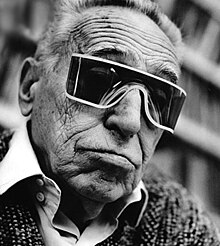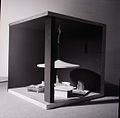art.wikisort.org - Artist
Achille Castiglioni (Italian pronunciation: [aˈkille kastiʎˈʎoːni]; 16 February 1918 – 2 December 2002) was an Italian designer of furniture, lighting, radiograms and other objects.[1][2][3]
This article may be expanded with text translated from the corresponding article in Italian. (October 2022) Click [show] for important translation instructions.
|
Achille Castiglioni | |
|---|---|
 | |
| Born | 16 February 1918 Milan, Italy |
| Died | 2 December 2002 (aged 84) Milan |
| Nationality | Italian |
| Awards | Compasso d'Oro and others |


Early life and education
Castiglioni was born on 16 February 1918 in Milan, in Lombardy in northern Italy. He was the third son of the sculptor Giannino Castiglioni and his wife Livia Bolla. His elder brothers Livio and Pier Giacomo were both architects.
Castiglioni studied classics at the Liceo Classico Giuseppe Parini in Milan, but switched to study the arts at the Liceo artistico di Brera. In 1937 he enrolled in the faculty of architecture of the Politecnico di Milano.[4] When the Second World War broke out, he became an officer in the artillery and was stationed on the Greek front and later in Sicily. He returned to Milan before the Allied Invasion of 1943. In March 1944 he graduated from the Politecnico.[4]
Work
Following the war, Castiglioni returned to Milan and joined the architectural design practice that his brothers Livio and Pier Giacomo had started with Luigi Caccia Dominioni in 1938.[5] Much of their work was in exhibition design, but they also carried out a number of architectural projects, including the reconstruction in 1952–53 of the Palazzo della Permanente, which had been destroyed by bombing in 1943.[4]
Livio Castiglioni left the practice in 1952. From then until Pier Giacomo died in 1968, he and Achille worked as a team; their designs are not attributable to either one of them.[5][4] After the death of Pier Giacomo, Castiglioni worked alone. From 1969 he taught architectural and design subjects, first at the Politecnico di Torino, and then, from 1980 when he became an ordinario or full professor, at the Politecnico di Milano.[4]
Together with Pier Giacomo, in 1957 he designed "Sella" and "Mezzardo" stools for Zanotta, as well as the "Cubo" couch for Arflex. In 1959, they began working with Kartell, designing lighting and furniture, including a collection of tables and stools called "Rochetto".[6][7] The Castiglioni brothers designed the "Lierna" chair for Cassina, and the "Taraxacum" chandelier for Flos in 1960. [8][9]: 173 [10][11]: 79 [12]: 356 Also for Flos, in 1962 they designed both the "Toio" lamp,[13] assembled from "ready-made" surplus hardware, and the "Arco" lamp,[14] which consists of a long arched stainless-steel cantilevered support, an adjustable shade made of perforated spun aluminium, and a heavy marble base.[4] These projects were followed in 1964 by the "Splüghen Braü" pendant light, and the "RR 126" radiogram for Brionvega.
Legacy
Throughout his lifetime, Castiglioni received many awards and distinctions for his designs, including eight Compasso d'Oro awards, as well as a Compasso d'Oro Career award "for having raised design to the highest values of culture through his irreplaceable experience."[15][16] His designs are held in museum collections around the world and several books have been published about his life and work.[citation needed]
In 1997, the Museum of Modern Art (MoMA) in New York staged a retrospective of his life and work titled: "Achille Castiglioni: Design!". The exhibition was curated by Paola Antonelli, who also wrote the catalogue.[17][18]
Achille Castiglioni died in Milan in 2002.[4]
Partial list of works


Architecture
- 1952-1953 Torre del Palazzo della Permanente, Milan (with Pier Giacomo Castiglioni)
- 1956 Church of San Gabriele Arcangelo in Mater Dei, Milan (with Pier Giacomo Castiglioni)
- 1958 Chamber of Commerce, Industry, and Agriculture, Milan (with Pier Giacomo Castiglioni)
- 1960 Splüghen Braü brewery, Milan (with Pier Giacomo Castiglioni)
- 1968 Omega Shop, Piazza Duomo, Milan (with Pier Giacomo Castiglioni)
- 1969 Casa Castiglioni, Milan
Exhibition and interior design
- 1954 Industrial Design Pavilion, Palazzo dell'Arte Bernocchi, X Triennale, Milan (with Pier Giacomo Castiglioni)
- 1957 "Colour and Form in the Modern Home" exhibit, Villa Olmo Como, Italy (with Pier Giacomo Castiglioni)
- 1963 "Vie d'acqua da Milano al mare", Palazzo Reale, Milan (with Pier Giacomo Castiglioni)
- 1965 "La casa abitata", Palazzo Strozzi, Florence (with Pier Giacomo Castiglioni)
- 1984 "Achille Castiglioni", Austrian Museum für Angewandte Kunst, Vienna
- 1988 "Le città del mondo e il futuro delle metropoli", XVII Triennale, Palazzo dell'arte, Milan
- 1995 "A la Castiglioni", Centre d'Art Santa Monica, Barcellona
- Industrial Design Pavilion, X Triennale di Milano, 1954 Palazzo dell'Arte Bernocchi. Photography Paolo Monti.
- Scale model
Awards and honours
- 1947 Milan Triennale Bronze Medal[19]
- 1951 Milan Triennale Grand Prix[19]
- 1954 Milan Triennale Grand Prix[19]
- 1955 Compasso d'oro Award, Luminator lamp (with Pier Giacomo Castiglioni)[20]
- 1957 Milan Triennale Gold Medal[19]
- 1957 Milan Triennale Silver Medal[19]
- 1960 Compasso d'oro Award, T12 Palini chair (with Pier Giacomo Castiglioni and Luigi Caccia Dominioni)[21]
- 1960 Milan Triennale Gold Medal[19]
- 1962 Compasso d'oro Award, l la caffè Pitagora (with Pier Giacomo Castiglioni)[22]
- 1963 Milan Triennale Silver Medal[19]
- 1964 Compasso d'oro Award, Spinamatic beer dispenser (with Pier Giacomo Castiglioni)[23]
- 1967 Compasso d'oro Award, Phoebus headset for simultaneous translations (with Pier Giacomo Castiglioni)
- 1979 Compasso d'oro Award, Parentesi lamp[24][25]
- 1979 Compasso d'oro Award, Omsa TR15 hospital bed (with Giancarlo Pozzi and Ernesto Zerbi)[26]
- 1984 Compasso d'oro Award, Dry cutlery[27]
- 1985 Honorary Member of the Advisory Commitee, ArtCenter College of Design, Pasadena, California
- 1986 Honorary Member, Royal Designers for Industry of the British Royal Society of Arts[28]
- 1987 Honorary Degree, Royal College of Art in London, UK
- 1989 Compasso d'Oro Career Award[15]
- 1993 Annual Award, Chartered Society of Designers in London, UK
- 1994 Spring of Design Award, Department of Culture, Catalonia, Spain
- 1995 Art sur Table Prize, Conseil National des Art Culinaire, Paris, France
- 1996 IF Design Award from the International Forum Design, Hannover, Germany
- 1996 Longevity (Langlebigkeit) Award from the Design Center in Stuttgart, Germany[29]
- 1999 Domus/INARCH, Lifetime Achievement Award, Milan, Italy
- 1999 "Targa d'Oro Unione Italiana per il Disegno", Faculty of Architecture, University of Genova, Italy[30]
- 1999 First place in the Competition "Supports for the Environment" organized by Enel, with the Michele De Lucchi
- 2001 Honorary Degree in Industrial Design, Milan Polytechnic University (Politecnico di Milano), Italy[19]
See also
References
- Achille Castiglioni Biography, London Design Museum Archived 24 August 2014 at the Wayback Machine
- Spalter in MOMA Collection
- Luminator in MOMA Collection
- Dario Scodeller (2015). Castiglioni, Achille (in Italian). Dizionario Biografico degli Italiani. Roma: Istituto dell’Enciclopedia Italiana. Accessed January 2016.
- William Hamilton (5 December 2002). Achille Castiglioni, 84, Italian Home Designer, Is Dead. New York Times. Accessed January 2016.
- "On the occasion of the Salone del Mobile 2018, the KARTELL museum opens a new exhibition dedicated to Achille and Pier Giacomo Castiglioni | Kartell". www.kartell.com. Retrieved 2 October 2022.
- "Kartell Rocchetto Stool designed by P-G. and A. Castiglioni, Denver Art Museum". www.denverartmuseum.org. Retrieved 2 October 2022.
- Lorenzo Morandotti (13 April 2014). Maestri del mobile (in Italian). Corriere di Como.
- Sergio Polano (ed.) (2001). Achille Castiglioni: tutte le opere, 1938-2000 (in Italian). Milan: Electa. ISBN 9788843575398.
- Sedia Lierna (in Italian). Fondazione Achille Castiglioni. Archived 14 July 2014.
- Giuliana Gramigna, Sergio Mazza (2003). Repertorio del design italiano 1950-2000 per l'arredamento domestico (in Italian). Torino; New York: U. Allemandi. ISBN 9788842211587.
- Giulio Castelli, Paola Antonelli, Francesca Picchi (2007). La fabbrica del design: conversazioni con i protagonisti del design italiano (in Italian). Milan: Skira. ISBN 9788861301443.
- "Achille Castiglioni, Pier Giacomo Castiglioni. Toio Floor Lamp. 1962 | MoMA". The Museum of Modern Art. Retrieved 13 September 2022.
- "Achille Castiglioni, Pier Giacomo Castiglioni. Arco Floor Lamp. 1962 | MoMA". The Museum of Modern Art. Retrieved 13 September 2022.
- "Compasso d'oro Career Award". ADI Design Museum. Retrieved 17 September 2022.
- Marelli, Di Carlotta (26 September 2018). "L'incoerenza creativa di Achille Castiglioni in 24 progetti-icona". ELLE Decor (in Italian). Retrieved 17 September 2022.
- "Achille Castiglioni: Design! | MoMA". The Museum of Modern Art. Curated by Paola Antonelli. Retrieved 1 October 2022.
{{cite web}}: CS1 maint: others (link) - Antonelli, Paola. "Achille Castiglioni: Design!" (PDF). Museum of Modern Art. Retrieved 1 October 2022.
- "Designculture • Achille Castiglioni". www.designculture.it. Retrieved 17 September 2022.
- "LUMINATOR LAMP". ADI Design Museum. Retrieved 17 September 2022.
- "T.12 PALINI". ADI Design Museum. Retrieved 17 September 2022.
- "FONDAZIONE ACHILLE CASTIGLIONI". Retrieved 17 September 2022.
- "SPINAMATIC". ADI Design Museum (in Italian). Retrieved 17 September 2022.
- "LAMPADA PARENTESI". ADI Design Museum (in Italian). Retrieved 17 September 2022.
- admin (23 March 2022). "10 famosi oggetti politecnici da Compasso d'Oro". Alumni (in Italian). Retrieved 17 September 2022.
- "LETTO TR 15". ADI Design Museum (in Italian). Retrieved 17 September 2022.
- "ADI - Associazione per il Disegno Industriale". www.adi-design.org. Retrieved 17 September 2022.
- "Past Royal Designers for Industry". The RSA. Retrieved 27 September 2022.
- "iF - Design Center Stuttgart". ifdesign.com (in German). Retrieved 17 September 2022.
- "Premi e riconoscimenti". Retrieved 17 September 2022.
На других языках
- [en] Achille Castiglioni
[fr] Achille Castiglioni
Achille Castiglioni (né le 16 février 1918 à Milan et mort le 2 décembre 2002[1] dans la même ville) est un designer italien du XXe siècle. Achille Castiglioni, comme son frère Pier Giacomo, subit l'influence matérielle de son père, le sculpteur Giannino Castiglioni.Другой контент может иметь иную лицензию. Перед использованием материалов сайта WikiSort.org внимательно изучите правила лицензирования конкретных элементов наполнения сайта.
WikiSort.org - проект по пересортировке и дополнению контента Википедии




